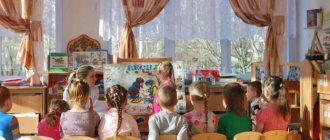How can a teacher greet children in the morning?
Children feel good about being treated, so don’t give them any reason to doubt that you are happy to see them.
- Smile. If possible, ask everyone how their day started, how they were feeling, and what interesting things happened in their lives. Start a dialogue with your parents.
- If a child has recently come to the group and has not yet had time to adapt, ask the parents to bring him before other children so that you have time to communicate with him individually. If there are several such children, assign them a specific arrival time so that they arrive at different times. In a separate article, read other tips on adapting children to kindergarten.
- Be attentive to children. Observe their emotional and physical state. If you notice any unhealthy signs, discuss them with your parents right away. Perhaps the child did not sleep well, which means he may be capricious during the day. Or he caught a cold, then it’s better to send him home.
- Pay attention to the child's appearance. Make sure that children change their shoes and clothes when entering the kindergarten. Help them if necessary.
- Watch children say goodbye to their parents. If this process is delayed or, on the contrary, happens too quickly, children may become upset after their parents leave. Tell parents about this and give recommendations on how to make goodbye more painless for the child.
- If your child is upset and doesn't want to stay in daycare, distract him and redirect his attention to something he enjoys. For example, to your favorite game or activity. Then the child will calm down faster and his mood will improve.
- Teach children to say hello when they meet - with teachers, with each other and with the parents of other children. This will help create a favorable environment in kindergarten and teach children to be polite and friendly.
After greeting the children individually, group activities can begin.
Consultation “Open classes as an effective form of methodological work”
Open lesson is one of the effective forms
organization of methodological work in preschool educational institutions
Increasing the level of skill of teachers is a priority area of methodological work, which occupies a special place in the management system of a preschool institution and represents an important link in the holistic system of advanced training of teaching staff. A constant connection between the content of methodological work and the results of teachers’ work ensures a continuous process of improving the professional skills of each educator.
Therefore, preschool educational institutions use new, effective forms of work that contribute to the activation of the teacher’s personality and the development of his creative personality.
Open classes are one of the effective forms of organizing methodological work in preschool educational institutions.
In educational practice, sometimes they do not distinguish between open and regular classes, and do not represent the features of preparing and conducting open classes.
An open lesson, unlike ordinary ones, is a specially prepared form of organizing methodological work, during which the main directions of the educational process of a preschool institution are implemented.
In an open lesson, the teacher shows his colleagues his positive or innovative experience in implementing a methodological idea, using a specific method or teaching method.
In this sense, an open lesson has a methodological goal, which contains the main points of what the teacher can show to those attending this lesson.
The purposes of open viewings are varied. Before the start of the lesson, the teacher first introduces the teachers to the lesson.
| I | Group characteristics: | - age characteristics of children; -the degree of children’s assimilation of the program; - real educational opportunities for children. |
| II | A story about the project for the upcoming lesson: | -place of the lesson in the topic, section, etc.; -goals, objectives of the lesson; -characteristics of educational content -material; -lesson structure. |
| III | Justification for the open lesson project | -relevance of the chosen topic of the lesson; - connection between the topic of the lesson and the methodological a problem, a topic of self-education that the teacher is working on. |
| IV | Open lesson plan | 1. The topic of the lesson and the “name” of the lesson. 2. Formulated methodological innovations proposed in the upcoming lesson. 3. Brief structural summary of the most interesting element of the lesson: supporting summary; samples of didactic materials (didactic games, handouts, sample, etc.); memos, booklets; list of used literature. |
There are a number of requirements for preparing and conducting open classes with preschool children.
1. Open classes are conducted by teachers who have a high level of scientific and methodological training and ensure high efficiency of the educational process;
2. An open lesson is a source of innovative experience and includes current problems of methodological science in the field of preschool pedagogy and psychology;
3. Open classes must be novel;
Novelty may relate to the content of didactic material or methods of studying it.
Showing classes in which methods that are widely used in practice are implemented does not contribute to the professional growth of other teachers.
In methodological work with young teachers, this limitation does not always need to be taken into account, since for them traditional, well-known methods are of a certain interest.
4. An open lesson as a form of organizing the educational process may itself contain a new, special structure;
5. An open lesson reflects the solution to a methodological problem, a topic of self-education, on which the teacher is working;
Its individual methodological theme is associated with the general methodological problem of the preschool educational institution team; it is this indicator within the framework of the lesson that contributes to the implementation of a systematic approach to the organization of scientific and methodological work in the teaching staff;
6. An open lesson shows (proves) the advantages or high efficiency of innovation or tradition in organizing children’s activities, therefore the teacher showing the open lesson chooses a topic whose content allows this to be done;
7. The teacher selects the topic of an open lesson in advance and prepares theoretical material, visuals, multimedia, classroom space, equipment, etc.;
8. When conducting an open lesson, all requirements for the educational process are met, the lesson is conducted under normal conditions, with a generally accepted duration, etc.;
9. An open lesson should not harm the system of knowledge, abilities and skills of children, their values.
Children should gain as much knowledge as they would have learned by studying this topic without anyone attending; it is also unacceptable to explain only that part of the lesson topic that allows you to most clearly demonstrate a new methodological technique, leaving the next part for another lesson or other activity.
10. A workplace must be prepared for visitors, which is located behind the children’s backs so that visitors do not distract their attention;
The visitor cannot be seated next to the child, on the side. The number of visitors to an open lesson cannot be unlimited. For example, in a group of 20 children invited to an open lesson, there are 10-15 teachers. Observations show that the attendance of classes by at least one stranger creates discomfort for both the teacher and the children, and therefore, it is now widely practiced to study the experience of teachers using video recordings of their professional activities.
11. Open classes and their content should not contradict the programs under which the teacher and the preschool educational institution as a whole work.
12. It is unacceptable to “rehearse” an open lesson with the same group or subgroup of children;
The day before, it is recommended to inform children and parents about an open lesson; this will prepare children for the situation when there will be visitors to the lesson;
13. Open viewings of classes and other activities are carried out in accordance with the methodological work plan of the preschool educational institution and teachers must have sufficient time to prepare it;
Practice shows that it is impossible to conduct several open classes in one group on the same day; it is also undesirable to conduct such classes in the same group within a month. This is explained by the great psychological stress that children and teachers experience.
14. When preparing an open lesson, the triune didactic goal must be taken into account: teaching, educating, developing and, additionally, motivational;
When preparing an open lesson, the teacher must take into account three types of motivation:
-social – creating a situation of success, using praise, encouragement, the child’s right to make mistakes;
-substantive – the formation of experience in collective and creative activity, the organization of individual work with children, the creation of a problem situation;
-pragmatic – to increase children’s attention to this type of activity, the development of cognitive interest in preparing the future student (FEMP, speech development, children’s experimentation, artistic activities, etc.).
15. To actualize children’s cognitive interest during an open lesson, a teacher can use a variety of methodological techniques:
- clear organization and planning of all parts of the lesson;
-intriguing beginning;
- taking into account the individual characteristics of children;
- friendly tone, gestures, facial expressions that are attractive to you;
- motives for activity.
Analysis of an open lesson with the participation of those who attended the lesson is not mandatory. If the methodological work plan of the preschool educational institution plans to analyze it, then first the floor is given to the teacher - the author of the lesson. It recalls the methodological goal of the lesson and gives a brief description of the work to achieve it. In contrast to the analysis of classes attended for the purpose of control, a discussion of open viewing involves consulting those present, reflection, active discussion, exchange of opinions, discussions, disputes, etc. .
Notes of all open classes are prepared and stored in the methodological office.
When preparing for an open lesson, a teacher needs to predict the expected results and expected risks.
Methodologically competent organization of open screenings of children's activities, including open classes, contributes to the continuous improvement of teacher qualifications in preschool educational institutions, comprehension of advanced pedagogical experience at a higher theoretical and practical level, and improves professional skills.
How can a teacher prepare for the arrival of children in kindergarten?
One teacher rushes to work, plans the first lesson on the go and greets the kids in an excited state. And the other one came to the kindergarten in advance, calmly prepared the room for class and set himself up for a productive day. Which teacher is more likely to win over children and parents?
Some tips on how to start your working day:
- Come to work early, 15-20 minutes before your first child arrives. You will need this time to prepare for class.
- Ventilate the room. Think about what games you will need for the first lesson and arrange them in a child-friendly way. For example, you can prepare sports equipment for morning exercises and select upbeat music.
- Think about questions you want to ask parents when you meet. For example, how the child feels, how he responds to the kindergarten at home, whether the child learned a song for the event.
If the teacher has prepared for the meeting with the children, he will come out to them in a calm and relaxed state. Parents will feel that their children remain in good hands.
Cognitive activities
Materials found: 143 Shown: 1 — 10
Integrated educational activity with children of middle preschool age on the topic “Zayushkina’s hut”
Program content. 1. Clarify knowledge about domestic and wild animals. 2. To form an idea of the meanings and functions of a traffic light. Instill traffic rules. 3. Strengthen the ability to determine the length of objects by...
FGT topic Furniture 2 junior group
“Rainbow” - topic “Furniture” Form ideas on the topic “Furniture” 2-ml. group To form an idea of the concept of “furniture”: • purpose; • Types of furniture; • Furniture parts; • What furniture is made from; • Methods of handling. Table,…
Three periods of autumn (compendium)
Summary of direct educational activities on the topic: “Three periods of autumn.” (preparatory group) Educational area “Cognition”: systematize children’s knowledge about autumn and autumn phenomena, consolidate ideas about...
Integrated lesson for children of senior preschool age using TRIZ “Oh, my bast shoes”
Goal: 1. Continue to develop the need for knowledge of the man-made world. 2. Improve knowledge about everyday objects (their color, shape, size, material, purpose. 3. Develop coherent speech. 4. Exercise in…
Summary of an open lesson with children of the preparatory group. NGO "Cognition", "Communication". on Topic: “The Journey of Water”
Lesson notes for the preparatory group Fr. O. “Cognition” “Communication” on the Topic: “The Journey of Water” Form of teaching: open lesson on cognitive and research activities of children. Number of children: subgroup Purpose:…
Summary of direct educational activities. "Autumn Fair"
Goals: to generate interest in the fair. Objectives: To summarize and systematize ideas about autumn according to the main, essential features, to consolidate knowledge about a person’s autumn preparations for winter in the garden. Activating the dictionary for...
Corrective lesson on the topic Clothes
Correctional lesson on the topic Clothes Goal: To develop the ability to differentiate clothes by season, to practice the use of pronouns, to use plural nouns in the nominative case in speech, to develop...
An educational activity with elements of work activity. “A hut is not red in its corners, but red in its pies”
Cognitive lesson with elements of work activity in the senior group. “A hut is not red in its corners - it is red in its pies” Goal: To introduce children to ancient household items and their purpose. Give children knowledge about what yeast is and...
Cognitive-speech lesson in the second junior group. "What grew in the garden"
Municipal budgetary preschool educational institution, child development center - kindergarten No. 19 “Joy” Cognitive - speech lesson in the second junior group TOPIC: “What grew in the garden” Prepared by: Marina Efimova...
Topic: “Journey to the Homeland of the Tomato”
Lushnikova M. V., teacher of the 2nd qualification category of the MKDOU D/s “Cherry”, Vargashi village.
Topic: “Journey to the homeland of the tomato.” Software tasks. Educational: to give children an idea of the plant’s need for light, ... Pages: ...
All sections




